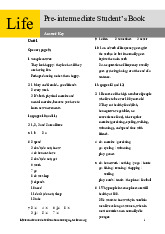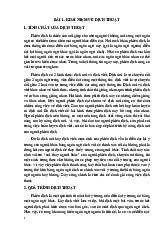





Preview text:
LESSON PLAN
TIẾNG ANH 11 FRIENDS GLOBAL
UNIT 3: SUSTAINABLE HEALTH
LESSON 3H – WRITING: AN OPINION ESSAY I. OBJECTIVES
By the end of this lesson, Ss will be able to: 1. Knowledge
- Know others’ opinions on sports and physical exercise.
- Gain useful language for introducing opinions, additional points, proposals and solutions, and conclusions.
- Know the structure of an opinion essay. 2. Competences
- Understand an opinion essay about teenagers not exercising enough. - Discuss sports at school.
- Write an essay about doing sport at school.
- Develop self-study skills, collaborative skills and communicative skills. 3. Personal qualities
- Build an awareness of the importance of physical exercise.
- Be collaborative and supportive in pair work and teamwork.
- Actively join in class activities. II. MATERIALS
- Grade 11 textbook, Unit 3, Writing
- Computer connected to the Internet - Projector / TV/ mini boards - PowerPoint Unit 3H III. PROCEDURES
1. ACTIVITY 1: WARM-UP (7 mins) a. Objectives:
- Introduce the new lesson and set the scene for Ss to acquire new language.
- Get students' attention at the beginning of the class.
- Activate Ss’ background knowledge.
- Students can gain more confidence and interest in the lesson. b. Content: - Danger 5 (Game) - Exercise 1. (p.45) c. Products:
- Students write on mini boards, discuss and report orally. d. Organisation
TEACHER’S AND STUDENTS’ ACTIVITIES CONTENT Danger 5. (5 mins)
- T goes through the instruction on the slides: 3 topics:
- Ss work in teams of 4-5 and have 2 minutes to write 5 1. Body parts words/phrases in a topic. 2. Individual Sports
- When they’re done, face the boards down. 3. Bad habits for your health
- After 2 minutes, T will check as a whole class.
- For each appropriate word/phrase, your team will get
+1, but if the other groups have the same words with
you, you will get -1 for each word.
- T can give an example before starting the game.
Exercise 1: Discuss the questions in pairs. Give reasons for your opinions. (2 mins)
- T asks students to think about what makes a lifestyle
1 Do you think most teenagers have a
healthy and elicit some ideas, e.g. eating healthy food, healthy lifestyle?
doing physical exercise, not smoking, sleeping well.
2 Do you have a healthy lifestyle? Why? /
- Students discuss the questions in pairs. Why not?
- A few students volunteer to share their ideas with the class. e. Assessment
- Teacher observes the groups and give feedback.
2. ACTIVITY 2: PRE-WRITING (20 mins) a. Objectives:
- Ss can analyse an essay prompt.
- Ss understand an opinion essay about teenagers not exercising enough.
- Ss know the structure of an opinion essay.
- Ss understand the Writing stategy.
- Ss gain some useful phrases to write an opinion essay. b. Content: - Exercise 2 (p.45)
- Pre-teach vocabulary related to the topic. - Exercise 3 (p.45) - Exercise 4 (p.45) - Exercise 5 (p.45) - Exercise 6 (p.45) c. Products:
- Ss take notes of new phrases, discuss with their friends, complete exercises in their books. d. Organisation
TEACHER’S AND STUDENTS’ ACTIVITIES CONTENT
Exercise 2: Read the task below. What two different elements does the task contain? (2 mins)
- T asks students to read the task and identify the two Answer: elements.
first element describe the problem (teenagers
- T checks answers as a class.
not getting enough exercise)
second element ways of solving this problem
Exercise 3: Read the essay. What is the writer’s opinion about the problem? How many solutions does she propose (3 mins)
- T asks students to read the essay and note down the Answer:
causes and possible solutions mentioned.
She thinks that the problem is serious. She - T csheck answers as a class
proposes two solutions: making school
canteens serve healthy food and giving
teenagers free membership of their local sports facilities.
Vocabulary teaching (3 mins)
- Teacher introduces the vocabulary.
- Ss underline the new words in the texts and match them with their synonyms.
- Teacher checks students’ understanding and conduct
oral drill chorally and individually.
- Ss take notes of the new vocab.
Exercise 4: Read the Writing Strategy. Does the writer follow all of the advice? Give examples (5 mins)
- T goes through the Writing Strategy, then asks Answers:
students to read the essay again and answer the Yes. questions.
1: 1 is an introduction, 2 and 3 are the main
- T goes through the slides to check answers as a class.
body and 4 is the conclusion.
2: 2 deals with the causes and 3 suggests solutions.
3: What is more, …; in order to …; Furthermore, …
4: I strongly believe …; What I propose is…;
I would strongly recommend …
Exercise 5: Complete the useful phrases with the words below and find them in the text in exercise 3. (4 mins)
- T goes through the instructions and encourages Answers:
students to try to complete the phrases without looking
1 view 2 opinion 3 seems 4 see 5 widely back at the essay.
6 said 7 common 8 What 9 solution 10
- Students can use their dictionaries to find the meaning propose 11 would 12 sum 13 conclusion
of the phrases if necessary. They then find twelve of the phrases in the essay. - T checks answers as a class
The phrases are I (strongly) believe that;
What is more, …; in order to tackle this
problem, …; in my view, …; What I
propose (instead) is that; Furthermore, …; I
would strongly recommend that; to conclude, …; it seems to me that
Exercise 6: Work in pairs. Read the task below and discuss questions 1–3. Write notes. (3 mins)
- T asks students: Do you do PE at school? Do you like 1 Which sports do you do at school? How
doing it or would you like to drop it? Why / Why not? often? - T elicits some answers.
2 Are there other subjects that are more
- Students read the task and the questions.
important than sport? Which ones? Why?
- Students discuss the questions in pairs and make notes 3 How could more sport be added to the from their discussion.
school timetable without affecting other
- T asks a few students to share their ideas with the subjects? class. e. Assessment
- Teacher checks students’ pronunciation and gives feedback.
- Teacher checks students’ understanding of writing strategy.
- Teacher observes Ss’ writing of vocabulary on their notebooks.
- Teacher observes group work and gives feedback.
3. ACTIVITY 3: WHILE WRITING (15 mins) a. Objectives:
- Ss can make a plan for their writing.
- Ss can write an essay about doing sports at school. b. Content: - Exercise 7. (p.45) - Exercise 8. (p.45) c. Products: - Students’ writings. d. Organisation
TEACHER’S AND STUDENTS’ ACTIVITIES CONTENT
Exercise 7: Using your notes from exercise 6, write a paragraph plan for your essay. Use the
essay in exercise 3 as a model and follow the advice in the Writing Strategy. (5 mins)
- Students write a paragraph plan using the Writing Strategy as a guide.
- T asks them to read the essay in exercise 3 again
for more ideas and encourage them to study how
the writer has used phrases from exercise 5.
- T shows an outline in the slide with guiding
questions as a sample for them to make their plan.
- Ss may work in pairs to create their plans in 5 minutes.
Exercise 8. Write your essay (150–180 words). Follow your paragraph plan from exercise 7 and
the advice in the Writing Strategy. Use phrases from exercise 5. (10 mins)
- Ss spend time writing their essays based on the Student’s performance plan they made in exercise 7.
- T circulates the classroom to monitor, takes
notes of some significant mistakes and provide
help with language if necessary. e. Assessment
- Teacher observation on Ss’ performance.
4. ACTIVITY 4: POST-WRITING (5 mins) a. Objectives:
- Ss can improve their speaking based on feedback. b. Content: - Check your work c. Products:
- Students take notes of their mistakes and how to improve their writings d. Organisation
TEACHER’S AND STUDENTS’ ACTIVITIES CONTENT Check your work (5 mins)
- Ss exchange their writings in pairs to give feedback to Have you …
their friends’ writings.
• followed all the advice in the Writing
- T gives feedback without saying who made the errors. Strategy?
- T selects randomly some writings to assess and gives
• included phrases from exercise 5?
more detailed feedback in the next class.
• checked your spelling and grammar? e. Assessment
- Teacher observation on Ss’ performance.
- Teacher’s feedback and peers’ feedback.
5. CONSOLIDATION (2 mins) a. Wrap-up
- If T is using the Classroom Presentation Tool, first do the lesson closer to review what has been covered in this lesson.
- T asks students: What have you learned today? What can you do now? and elicits answers: I
can write an essay about sport at school. I can plan an essay and use phrases for introducing
my and other people’s opinions, making additional points, introducing proposals and solutions and concluding b. Homework
- Prepare for the next lesson




